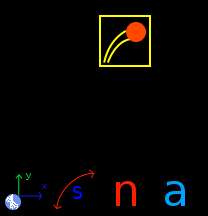Next: Example 3, Previous: Example 1, Up: Examples circular kinematics of particles [Contents][Index]
5.2 Example 2
A mobile left the rest describing a circular motion with radius 4.7 m. If the tangential acceleration is 1.6 m/s2, How many seconds need to travel a distance of 256 m? How many laps have done? What is the total acceleration in that moment (after travel the 256 m)?
Solution with FisicaLab
Select the Kinematic group and, inside this, the Particles circular module. Erase the content of the chalkboard and select the SI system. Now add one element Mobile with circular motion, one element Arc length, one element Number of laps, one element Total acceleration and one element Stationary reference system. As show the image below:

The time is unknown, then to the Stationary reference system we have:
- tf
t
Now to the element Mobile with circular motion, we call it Mobile, we assume that its initial position correspond with angle 0. And, to this problem, we don’t need a center of rotation:
- Name
Mobile
- C
0
- r
4.7
- aci
aci
- at
1.6
- angi
0
- vi
0
- ti
0
- angf
angf
- vf
vf
- acf
acf
To the element Arc length we have:
- Object
Mobile
- s
256
Now to the element Number of laps:
- Object
Mobile
- n
n
And to the element Total acceleration:
- Object
Mobile
- atoti
atoti
- angi
aangi
- atotf
atotf
- angf
aangf
Now click in the icon Solve to get the answer:
aci = -0.000 m/s2 ; angf = 240.791 degrees ; vf = 28.622 m/s ; acf = 174.298 m/s2 ; t = 17.889 s ; n = 8.669 rev ; atoti = 1.600 m/s2 ; aangi = 90.000 degrees ; atotf = 174.305 m/s2 ; aangf = 179.474 degrees ; Status = success.
Remember that the angle of the total acceleration vector is measured from the radius vector.